Fire-Retardant Flexible Foamed Polyurethane (PU)-Based Composites: Armed and Charmed Ground Tire Rubber (GTR) Particles
Abstract
1. Introduction
2. Materials and Methods
2.1. Materials
2.2. Modifications of GTR
2.3. Preparation of PU/GTR Composite Foams
2.4. Characterization Techniques
3. Results and Discussion
3.1. Microstructure and Physico-Mechanical Performance of PU/GTR Composite Foams
3.2. Thermal Stability of PU/GTR Composite Foams
3.3. Flammability of PU/GTR Composite Foams
4. Conclusions
Supplementary Materials
Author Contributions
Funding
Institutional Review Board Statement
Data Availability Statement
Conflicts of Interest
References
- Next Move Strategy Consulting. Construction Market by Construction Type (Addition, Re-Development and New Constructions), by Sector (Commercial Construction, Residential Construction, Industrial Construction, Infrastructure Construction, Energy and Utilities Construction)—Global Opportunity Analysis and Industry Forecast, 2024–2030. 2024. Available online: https://www.nextmsc.com/report/construction-market (accessed on 1 February 2024).
- Research and Markets. Construction Global Market Opportunities and Strategies To 2032. 2023. Available online: https://www.researchandmarkets.com/report/construction (accessed on 1 February 2024).
- Sun, C.; Xu, Z.; Zheng, H. Green Transformation of the Building Industry and the Government Policy Effects: Policy Simulation Based on the DSGE Model. Energy 2023, 268, 126721. [Google Scholar] [CrossRef]
- Datta, S.D.; Tayeh, B.A.; Hakeem, I.Y.; Abu Aisheh, Y.I. Benefits and Barriers of Implementing Building Information Modeling Techniques for Sustainable Practices in the Construction Industry—A Comprehensive Review. Sustainability 2023, 15, 12466. [Google Scholar] [CrossRef]
- Zhang, R.; Tang, Y.; Zhang, Y.; Wang, Z. Collaborative Relationship Discovery in Green Building Technology Innovation: Evidence from Patents in China’s Construction Industry. J. Clean. Prod. 2023, 391, 136041. [Google Scholar] [CrossRef]
- European Comission Communication from The Commission to The European Parliament, the Council, the European Economic and Social Committee of the Regions. A New Circular Economy Action Plan For a Cleaner and More Competitive Europe. 2020. Available online: https://eur-lex.europa.eu/legal-content/EN/TXT/?qid=1583933814386&uri=COM:2020:98:FIN (accessed on 1 February 2024).
- European Comission State of the Union: Commission Raises Climate Ambition and Proposes 55% Cut in Emissions by 2030. 2020. Available online: https://ec.europa.eu/commission/presscorner/detail/en/ip_20_1599 (accessed on 1 February 2024).
- European Comission The European Green Deal Sets out How to Make Europe the First Climate-Neutral Continent by 2050, Boosting the Economy, Improving People’s Health and Quality of Life, Caring for Nature, and Leaving No One behind. 2019. Available online: https://ec.europa.eu/commission/presscorner/detail/en/ip_19_6691 (accessed on 1 February 2024).
- Mesfin, S.; Gnanadurai Rengiah, R.; Shiferaw, M.; Guadie, T. Effect of Fiber Content on Tensile and Flexural Strength of Water Lily Fiber Reinforced Polyester Resin Composite. Compos. Theory Pract. 2023, 23, 113–117. [Google Scholar]
- Rathore, R.; Bhattacharjee, S.; Bora, P.; Rao, G.S.; Samanta, S.; Debnath, K. Effect of Injection Parameters on Tensile and Flexural Properties of Green Composites. Compos. Theory Pract. 2022, 22, 196–204. [Google Scholar]
- Ates, M.; Karadag, S.; Eker, A.A.; Eker, B. Polyurethane Foam Materials and Their Industrial Applications. Polym. Int. 2022, 71, 1157–1163. [Google Scholar] [CrossRef]
- Augaitis, N.; Vaitkus, S.; Członka, S.; Kairytė, A. Research of Wood Waste as a Potential Filler for Loose-Fill Building Insulation: Appropriate Selection and Incorporation into Polyurethane Biocomposite Foams. Materials 2020, 13, 5336. [Google Scholar] [CrossRef] [PubMed]
- Briones-Llorente, R.; Barbosa, R.; Almeida, M.; Montero García, E.A.; Rodríguez Saiz, Á. Ecological Design of New Efficient Energy-Performance Construction Materials with Rigid Polyurethane Foam Waste. Polymer 2020, 12, 1048. [Google Scholar] [CrossRef]
- de Oliveira, B.P.; Balieiro, L.C.S.; Maia, L.S.; Zanini, N.C.; Teixeira, E.J.O.; da Conceição, M.O.T.; Medeiros, S.F.; Mulinari, D.R. Eco-FRIendly Polyurethane Foams Based on Castor Polyol Reinforced with Açaí Residues for Building Insulation. J. Mater. Cycles Waste Manag. 2022, 24, 553–568. [Google Scholar] [CrossRef]
- Marchewka, I.; Downar-Zapolska, E.; Pichór, W. Thermal, Mechanical and Moisture Properties of Polymer Plaster Modified with Lightweight Fillers. Compos. Theory Pract. 2022, 22, 160–165. [Google Scholar]
- Mohapatra, D.K.; Deo, C.R.; Mishra, P. Investigation of Glass Fiber Influence on Mechanical Characteristics of Natural Fiber Reinforced Polyester Composites: An Experimental and Numerical Approach. Compos. Theory Pract. 2022, 22, 123–129. [Google Scholar]
- Głodniok, M.; Korol, J.; Zawartka, P. Properties of Developed Synthetic Lightweight Aggregate (Composite) Based on Hydraulic Binders and Waste. Compos. Theory Pract. 2022, 22, 191–195. [Google Scholar]
- Posmyk, A. Influence of Air Gap on Insulating Performance of Composite Coatings on Pipes for Hot Media Transport. Compos. Theory Pract. 2022, 22, 54–57. [Google Scholar]
- Posmyk, A. Method of Investigating Thermal Conductivity of Insulating Composite Materials Designed for the Means of Transport. Compos. Theory Pract. 2018, 18, 145–148. [Google Scholar]
- Serrano, L.; Rincón, E.; García, A.; Rodríguez, J.; Briones, R. Bio-Degradable Polyurethane Foams Produced by Liquefied Polyol from Wheat Straw Biomass. Polymer 2020, 12, 2646. [Google Scholar] [CrossRef]
- Uram, K.; Prociak, A.; Kurańska, M. Influence of the Chemical Structure of Rapeseed Oil-Based Polyols on Selected Properties of Polyurethane Foams. Polimery 2020, 65, 698–707. [Google Scholar] [CrossRef]
- Akdogan, E.; Erdem, M. A Comprehensive Research of Low-Density Bio-Based Rigid Polyurethane Foams from Sugar Beet Pulp-Based Biopolyol: From Closed-Cell towards Open-Cell Structure. Ind. Crops Prod. 2023, 200, 116809. [Google Scholar] [CrossRef]
- Członka, S.; Strąkowska, A.; Kairytė, A. Application of Walnut Shells-Derived Biopolyol in the Synthesis of Rigid Polyurethane Foams. Materials 2020, 13, 2687. [Google Scholar] [CrossRef]
- Jasiūnas, L.; McKenna, S.T.; Bridžiuvienė, D.; Miknius, L. Mechanical, Thermal Properties and Stability of Rigid Polyurethane Foams Produced with Crude-Glycerol Derived Biomass Biopolyols. J. Polym. Environ. 2020, 28, 1378–1389. [Google Scholar] [CrossRef]
- Ma, Q.; Fu, K.; Zhang, J.; Li, M.; Han, X.; Chen, Z.; Ma, L.; Chang, C. New Bio-Based Polyurethane (PU) Foams Synthesized Using Crude Glycerol-Based Biopolyol and Humin-Based Byproducts from Biomass Hydrolysis. Ind. Crops Prod. 2023, 205, 117548. [Google Scholar] [CrossRef]
- Gurgel, D.; Bresolin, D.; Sayer, C.; Cardozo Filho, L.; Hermes de Araújo, P.H. Flexible Polyurethane Foams Produced from Industrial Residues and Castor Oil. Ind. Crops Prod. 2021, 164, 113377. [Google Scholar] [CrossRef]
- El Khezraji, S.; Ben youcef, H.; Belachemi, L.; Lopez Manchado, M.A.; Verdejo, R.; Lahcini, M. Recent Progress of Non-Isocyanate Polyurethane Foam and Their Challenges. Polymer 2023, 15, 254. [Google Scholar] [CrossRef] [PubMed]
- Monie, F.; Grignard, B.; Thomassin, J.; Mereau, R.; Tassaing, T.; Jerome, C.; Detrembleur, C. Chemo- and Regioselective Additions of Nucleophiles to Cyclic Carbonates for the Preparation of Self-Blowing Non-Isocyanate Polyurethane Foams. Angew. Chem. 2020, 132, 17181–17189. [Google Scholar] [CrossRef]
- Bourguignon, M.; Grignard, B.; Detrembleur, C. Water-Induced Self-Blown Non-Isocyanate Polyurethane Foams. Angew. Chem. Int. Ed. 2022, 61, e202213422. [Google Scholar] [CrossRef] [PubMed]
- Gomez-Lopez, A.; Elizalde, F.; Calvo, I.; Sardon, H. Trends in Non-Isocyanate Polyurethane (NIPU) Development. Chem. Commun. 2021, 57, 12254–12265. [Google Scholar] [CrossRef] [PubMed]
- Uram, K.; Leszczyńska, M.; Prociak, A.; Czajka, A.; Gloc, M.; Leszczyński, M.K.; Michałowski, S.; Ryszkowska, J. Polyurethane Composite Foams Synthesized Using Bio-Polyols and Cellulose Filler. Materials 2021, 14, 3474. [Google Scholar] [CrossRef] [PubMed]
- Leszczyńska, M.; Malewska, E.; Ryszkowska, J.; Kurańska, M.; Gloc, M.; Leszczyński, M.K.; Prociak, A. Vegetable Fillers and Rapeseed Oil-Based Polyol as Natural Raw Materials for the Production of Rigid Polyurethane Foams. Materials 2021, 14, 1772. [Google Scholar] [CrossRef]
- De Luca Bossa, F.; Santillo, C.; Verdolotti, L.; Campaner, P.; Minigher, A.; Boggioni, L.; Losio, S.; Coccia, F.; Iannace, S.; Lama, G.C. Greener Nanocomposite Polyurethane Foam Based on Sustainable Polyol and Natural Fillers: Investigation of Chemico-Physical and Mechanical Properties. Materials 2020, 13, 211. [Google Scholar] [CrossRef]
- Sture, B.; Vevere, L.; Kirpluks, M.; Godina, D.; FRIdrihsone, A.; Cabulis, U. Polyurethane Foam Composites Reinforced with Renewable Fillers for Cryogenic Insulation. Polymer 2021, 13, 4089. [Google Scholar] [CrossRef]
- Kosmela, P.; Olszewski, A.; Zedler, Ł.; Burger, P.; Piasecki, A.; Formela, K.; Hejna, A. Ground Tire Rubber Filled Flexible Polyurethane Foam—Effect of Waste Rubber Treatment on Composite Performance. Materials 2021, 14, 3807. [Google Scholar] [CrossRef]
- Barczewski, M.; Kurańska, M.; Sałasińska, K.; Michałowski, S.; Prociak, A.; Uram, K.; Lewandowski, K. Rigid Polyurethane Foams Modified with Thermoset Polyester-Glass Fiber Composite Waste. Polym. Test. 2020, 81, 106190. [Google Scholar] [CrossRef]
- Kairytė, A.; Kremensas, A.; Vaitkus, S.; Członka, S.; Strąkowska, A. Fire Suppression and Thermal Behavior of Biobased Rigid Polyurethane Foam Filled with Biomass Incineration Waste Ash. Polymer 2020, 12, 683. [Google Scholar] [CrossRef]
- Paciorek-Sadowska, J.; Borowicz, M.; Isbrandt, M. Evaluation of the Effect of Waste from Agricultural Production on the Properties of Flexible Polyurethane Foams. Polymer 2023, 15, 3529. [Google Scholar] [CrossRef]
- Recupido, F.; Lama, G.C.; Lavorgna, M.; Buonocore, G.G.; Marzella, R.; Verdolotti, L. Post-Consumer Recycling of Tetra Pak®: Starting a “New Life” as Filler in Sustainable Polyurethane Foams. Food Packag. Shelf Life 2023, 40, 101175. [Google Scholar] [CrossRef]
- Ustuntag, S.; Cakir, N.; Erdem, A.; Ozmen, O.; Dogan, M. Production and Characterization of Flame Retardant Leather Waste Filled Thermoplastic Polyurethane. ACS Omega 2024, 9, 9475–9485. [Google Scholar] [CrossRef]
- Tu, B.; Zhou, K.; Zhou, Q.; Gong, K.; Hu, D. Waste to Resource: Preparation of an Efficient Adsorbent and Its Sustainable Utilization in Flame Retardant Polyurethane Composites. RSC Adv. 2021, 11, 9942–9954. [Google Scholar] [CrossRef] [PubMed]
- Li, H.; Mahmood, N.; Ma, Z.; Zhu, M.; Wang, J.; Zheng, J.; Yuan, Z.; Wei, Q.; Xu, C. (Chunbao) Preparation and Characterization of Bio-Polyol and Bio-Based Flexible Polyurethane Foams from Fast Pyrolysis of Wheat Straw. Ind. Crops Prod. 2017, 103, 64–72. [Google Scholar] [CrossRef]
- Li, Y. Development of Polyurethane Foam and Its Potential within the Biofuels Market. Biofuels 2011, 2, 357–359. [Google Scholar] [CrossRef]
- Gutiérrez-González, S.; Gadea, J.; Rodríguez, A.; Junco, C.; Calderón, V. Lightweight Plaster Materials with Enhanced Thermal Properties Made with Polyurethane Foam Wastes. Constr. Build. Mater. 2012, 28, 653–658. [Google Scholar] [CrossRef]
- Tiuc, A.E.; Nemeş, O.; Vermeşan, H.; Toma, A.C. New Sound Absorbent Composite Materials Based on Sawdust and Polyurethane Foam. Compos. B Eng. 2019, 165, 120–130. [Google Scholar] [CrossRef]
- Yang, C.; Zhuang, Z.; Yang, Z. Pulverized Polyurethane Foam Particles Reinforced Rigid Polyurethane Foam and Phenolic Foam. J. Appl. Polym. Sci. 2014, 131, 39734. [Google Scholar] [CrossRef]
- Hýsek, Š.; Neuberger, P.; Sikora, A.; Schönfelder, O.; Ditommaso, G. Waste Utilization: Insulation Panel from Recycled Polyurethane Particles and Wheat Husks. Materials 2019, 12, 3075. [Google Scholar] [CrossRef] [PubMed]
- El-Meligy, M.G.; Mohamed, S.H.; Mahani, R.M. Study Mechanical, Swelling and Dielectric Properties of Prehydrolysed Banana Fiber—Waste Polyurethane Foam Composites. Carbohydr. Polym. 2010, 80, 366–372. [Google Scholar] [CrossRef]
- Członka, S.; Bertino, M.F.; Strzelec, K.; Strąkowska, A.; Masłowski, M. Rigid Polyurethane Foams Reinforced with Solid Waste Generated in Leather Industry. Polym. Test. 2018, 69, 225–237. [Google Scholar] [CrossRef]
- Tiuc, A.-E.; Vermeşan, H.; Gabor, T.; Vasile, O. Improved Sound Absorption Properties of Polyurethane Foam Mixed with Textile Waste. Energy Procedia 2016, 85, 559–565. [Google Scholar] [CrossRef]
- Cachaço, A.G.; Afonso, M.D.; Pinto, M.L. New Applications for Foam Composites of Polyurethane and Recycled Rubber. J. Appl. Polym. Sci. 2013, 129, 2873–2881. [Google Scholar] [CrossRef]
- Hejna, A.; Kosmela, P.; Olszewski, A.; Zedler, Ł.; Formela, K.; Skórczewska, K.; Piasecki, A.; Marć, M.; Barczewski, R.; Barczewski, M. Management of Ground Tire Rubber Waste by Incorporation into Polyurethane-Based Composite Foams. Environ. Sci. Pollut. Res. 2023; in press. [Google Scholar] [CrossRef]
- Żukowska, W.; Kosmela, P.; Wojtasz, P.; Szczepański, M.; Piasecki, A.; Barczewski, R.; Barczewski, M.; Hejna, A. Comprehensive Enhancement of Prepolymer-Based Flexible Polyurethane Foams’ Performance by Introduction of Cost-Effective Waste-Based Ground Tire Rubber Particles. Materials 2022, 15, 5728. [Google Scholar] [CrossRef]
- Hejna, A.; Korol, J.; Przybysz-Romatowska, M.; Zedler, Ł.; Chmielnicki, B.; Formela, K. Waste Tire Rubber as Low-Cost and Environmentally-FRIendly Modifier in Thermoset Polymers—A Review. Waste Manag. 2020, 108, 106–118. [Google Scholar] [CrossRef]
- Chattopadhyay, D.K.; Webster, D.C. Thermal Stability and Flame Retardancy of Polyurethanes. Prog. Polym. Sci. 2009, 34, 1068–1133. [Google Scholar] [CrossRef]
- Yadav, A.; de Souza, F.M.; Dawsey, T.; Gupta, R.K. Recent Advancements in Flame-Retardant Polyurethane Foams: A Review. Ind. Eng. Chem. Res. 2022, 61, 15046–15065. [Google Scholar] [CrossRef]
- Wiśniewska, P.; Wójcik, N.A.; Ryl, J.; Bogdanowicz, R.; Vahabi, H.; Formela, K.; Saeb, M.R. Rubber Wastes Recycling for Developing Advanced Polymer Composites: A Warm Handshake with Sustainability. J. Clean. Prod. 2023, 427, 139010. [Google Scholar] [CrossRef]
- Ryszkowska, J.; Leszczynska, M.; Auguscik, M.; Bryskiewicz, A.; Polka, M.; Kukfisz, B.; Wierzbicki, L.; Aleksandrowicz, J.; Szczepkowski, L.; Oliwa, R. Cores of Composite Structures Made of Semi-Rigid Foams for Use as Protecting Shields for Firefighters. Polimery 2018, 63, 125–133. [Google Scholar] [CrossRef]
- PN-EN ISO 1798:2009; Elastyczne Tworzywa Sztuczne Porowate—Oznaczanie Wytrzymałości na Rozciąganie i Wydłużenia przy Zerwaniu. Polski Komitet Normalizacyjny: Warszawa, Poland, 2009.
- PN-EN ISO 604:2006; Tworzywa Sztuczne—Oznaczanie Właściwości przy Ściskaniu. Polski Komitet Normalizacyjny: Warszawa, Poland, 2006.
- ISO 5660-1:2015; Heat Release, Smoke Production and Mass Loss Rate Part 1: Heat Release Rate (Cone Calorimeter Method) and Smoke Production Rate (Dynamic Measurement). International Organization for Standardization: Geneva, Switzerland, 2015.
- PN-EN ISO 4589-2:2006/A1:2006; Tworzywa Sztuczne—Oznaczanie Zapalności Metodą Wskaźnika Tlenowego—Część 2: Badanie w Temperaturze Pokojowej. Polski Komitet Normalizacyjny: Warszawa, Poland, 2006.
- Stachak, P.; Hebda, E.; Pielichowski, K. Foaming Extrusion of Thermoplastic Polyurethane Modified by POSS Nanofillers. Compos. Theory Pract. 2019, 19, 23–29. [Google Scholar]
- Smoleń, J.; Olszowska, K.; Godzierz, M. Composites of Rigid Polyurethane Foam and Shredded Car Window Glass Particles—Structure and Mechanical Properties. Compos. Theory Pract. 2021, 21, 135–140. [Google Scholar]
- Li, Y.; Zou, J.; Zhou, S.; Chen, Y.; Zou, H.; Liang, M.; Luo, W. Effect of Expandable Graphite Particle Size on the Flame Retardant, Mechanical, and Thermal Properties of Water-Blown Semi-Rigid Polyurethane Foam. J. Appl. Polym. Sci. 2014, 131, 39885. [Google Scholar] [CrossRef]
- Acuña, P.; Li, Z.; Santiago-Calvo, M.; Villafañe, F.; Rodríguez-Perez, M.; Wang, D.-Y. Influence of the Characteristics of Expandable Graphite on the Morphology, Thermal Properties, Fire Behaviour and Compression Performance of a Rigid Polyurethane Foam. Polymer 2019, 11, 168. [Google Scholar] [CrossRef] [PubMed]
- Seo, J.; Jeong, S.-G.; Kim, S.; Huh, W. Improvement of Thermal Conductivity of Underlay Foam for Laminate Flooring to Reduce Heating Energy. Bioresources 2016, 11, 9059–9067. [Google Scholar] [CrossRef][Green Version]
- Hejna, A.; Kosmela, P.; Olszewski, A.; Formela, K.; Zedler, Ł.; Piasecki, A.; Skórczewska, K. The Impact of Filler Thermomechanical Modifications on Static and Dynamic Mechanical Performance of Flexible Foamed Polyurethane/Ground Tire Rubber/Zinc Borate Composites. Compos. Theory Pract. 2023, 23, 76–83. [Google Scholar]
- Lee, P.S.; Jung, S.M. Flame Retardancy of Polyurethane Foams Prepared from Green Polyols with Flame Retardants. J. Appl. Polym. Sci. 2022, 139, 52010. [Google Scholar] [CrossRef]
- Gürkan, E.H.; Yaman, B. Comparative Evaluation of Flame Retardant Performance in Rigid Polyurethane Foams: TCPP, TDCP MP, and ATH as Promising Additives. J. Taibah Univ. Sci. 2023, 17, 2233757. [Google Scholar] [CrossRef]
- Thirumal, M.; Khastgir, D.; Singha, N.K.; Manjunath, B.S.; Naik, Y.P. Effect of Expandable Graphite on the Properties of Intumescent Flame-retardant Polyurethane Foam. J. Appl. Polym. Sci. 2008, 110, 2586–2594. [Google Scholar] [CrossRef]
- Jeyapragash, R.; Sathiyamurthy, S.; Srinivasan, V.; Prithivirajan, R.; Swaminathan, G. Properties and Characteristics of Alkali Treated Calotropis Gigantea Fiber-Reinforced Particle-Filled Epoxy Composites. Compos. Theory Pract. 2022, 22, 99–105. [Google Scholar]
- Modesti, M.; Lorenzetti, A. Flame Retardancy of Polyisocyanurate–Polyurethane Foams: Use of Different Charring Agents. Polym. Degrad. Stab. 2002, 78, 341–347. [Google Scholar] [CrossRef]
- Modesti, M.; Lorenzetti, A.; Simioni, F.; Checchin, M. Influence of Different Flame Retardants on Fire Behaviour of Modified PIR/PUR Polymers. Polym. Degrad. Stab. 2001, 74, 475–479. [Google Scholar] [CrossRef]
- Konig, A.; Fehrenbacher, U.; Hirth, T.; Kroke, E. Flexible Polyurethane Foam with the Flame-Retardant Melamine. J. Cell. Plast. 2008, 44, 469–480. [Google Scholar] [CrossRef]
- Kageoka, M.; Tairaka, Y.; Kodama, K. Effects of Melamine Particle Size on Flexible Polyurethane Foam Properties. J. Cell. Plast. 1997, 33, 219–237. [Google Scholar] [CrossRef]
- Mequanint, K.; Sanderson, R.; Pasch, H. Thermogravimetric Study of Phosphated Polyurethane Ionomers. Polym. Degrad. Stab. 2002, 77, 121–128. [Google Scholar] [CrossRef]
- Zhu, S.; Shi, W. Synthesis, Characterization and Flame Retardancy of Methacrylated Phosphate/Diphosphate. Polym. Int. 2004, 53, 266–271. [Google Scholar] [CrossRef]
- Chao, C.Y.H.; Wang, J.H. Comparison of the Thermal Decomposition Behavior of a Non-Fire Retarded and a Fire Retarded Flexible Polyurethane Foam with Phosphorus and Brominated Additives. J. Fire Sci. 2001, 19, 137–156. [Google Scholar] [CrossRef]
- van der Veen, I.; de Boer, J. Phosphorus Flame Retardants: Properties, Production, Environmental Occurrence, Toxicity and Analysis. Chemosphere 2012, 88, 1119–1153. [Google Scholar] [CrossRef]
- Liu, X.; Salmeia, K.A.; Rentsch, D.; Hao, J.; Gaan, S. Thermal Decomposition and Flammability of Rigid PU Foams Containing Some DOPO Derivatives and Other Phosphorus Compounds. J. Anal. Appl. Pyrolysis 2017, 124, 219–229. [Google Scholar] [CrossRef]
- Petrović, Z.S.; Zavargo, Z.; Flyn, J.H.; Macknight, W.J. Thermal Degradation of Segmented Polyurethanes. J. Appl. Polym. Sci. 1994, 51, 1087–1095. [Google Scholar] [CrossRef]
- Nadal Gisbert, A.; Crespo Amorós, J.E.; López Martínez, J.; Garcia, A.M. Study of Thermal Degradation Kinetics of Elastomeric Powder (Ground Tire Rubber). Polym. Plast. Technol. Eng. 2007, 47, 36–39. [Google Scholar] [CrossRef]
- Davies, P.J.; Horrocks, A.R.; Alderson, A. The Sensitisation of Thermal Decomposition of Ammonium Polyphosphate by Selected Metal Ions and Their Potential for Improved Cotton Fabric Flame Retardancy. Polym. Degrad. Stab. 2005, 88, 114–122. [Google Scholar] [CrossRef]
- Jiang, W.; Hao, J.; Han, Z. Study on the Thermal Degradation of Mixtures of Ammonium Polyphosphate and a Novel Caged Bicyclic Phosphate and Their Flame Retardant Effect in Polypropylene. Polym. Degrad. Stab. 2012, 97, 632–637. [Google Scholar] [CrossRef]
- Sangeetha, V.; Kanagathara, N.; Sumathi, R.; Sivakumar, N.; Anbalagan, G. Spectral and Thermal Degradation of Melamine Cyanurate. J. Mater. 2013, 2013, 262094. [Google Scholar] [CrossRef]
- Wang, G.; Yang, J. Thermal Degradation Study of Fire Resistive Coating Containing Melamine Polyphosphate and Dipentaerythritol. Prog. Org. Coat. 2011, 72, 605–611. [Google Scholar] [CrossRef]
- Liu, G.; Chen, W.; Yu, J. A Novel Process to Prepare Ammonium Polyphosphate with Crystalline Form II and Its Comparison with Melamine Polyphosphate. Ind. Eng. Chem. Res. 2010, 49, 12148–12155. [Google Scholar] [CrossRef]
- Vahabi, H.; Laoutid, F.; Mehrpouya, M.; Saeb, M.R.; Dubois, P. Flame Retardant Polymer Materials: An Update and the Future for 3D Printing Developments. Mater. Sci. Eng. R Rep. 2021, 144, 100604. [Google Scholar] [CrossRef]
- Vahabi, H.; Jouyandeh, M.; Cochez, M.; Khalili, R.; Vagner, C.; Ferriol, M.; Movahedifar, E.; Ramezanzadeh, B.; Rostami, M.; Ranjbar, Z.; et al. Short-Lasting Fire in Partially and Completely Cured Epoxy Coatings Containing Expandable Graphite and Halloysite Nanotube Additives. Prog. Org. Coat. 2018, 123, 160–167. [Google Scholar] [CrossRef]
- Quan, Y.; Zhang, Z.; Tanchak, R.N.; Wang, Q. A Review on Cone Calorimeter for Assessment of Flame-Retarded Polymer Composites. J. Therm. Anal. Calorim. 2022, 147, 10209–10234. [Google Scholar] [CrossRef]
- Schartel, B.; Hull, T.R. Development of Fire-Retarded Materials—Interpretation of Cone Calorimeter Data. Fire Mater. 2007, 31, 327–354. [Google Scholar] [CrossRef]
- Akdogan, E.; Erdem, M.; Ureyen, M.E.; Kaya, M. Synergistic Effects of Expandable Graphite and Ammonium Pentaborate Octahydrate on the Flame-retardant, Thermal Insulation, and Mechanical Properties of Rigid Polyurethane Foam. Polym. Compos. 2020, 41, 1749–1762. [Google Scholar] [CrossRef]
- Mazela, B.; Batista, A.; Grześkowiak, W. Expandable Graphite as a Fire Retardant for Cellulosic Materials—A Review. Forests 2020, 11, 755. [Google Scholar] [CrossRef]
- Lv, Y.F.; Thomas, W.; Chalk, R.; Singamneni, S. Flame Retardant Polymeric Materials for Additive Manufacturing. Mater. Today Proc. 2020, 33, 5720–5724. [Google Scholar] [CrossRef]
- Levchik, S.V.; Weil, E.D. Thermal Decomposition, Combustion and Fire-Retardancy of Polyurethanes—A Review of the Recent Literature. Polym. Int. 2004, 53, 1585–1610. [Google Scholar] [CrossRef]
- Salasinska, K.; Borucka, M.; Leszczyńska, M.; Zatorski, W.; Celiński, M.; Gajek, A.; Ryszkowska, J. Analysis of Flammability and Smoke Emission of Rigid Polyurethane Foams Modified with Nanoparticles and Halogen-Free Fire Retardants. J. Therm. Anal. Calorim. 2017, 130, 131–141. [Google Scholar] [CrossRef]
- Okrasa, M.; Leszczyńska, M.; Sałasińska, K.; Szczepkowski, L.; Kozikowski, P.; Nowak, A.; Szulc, J.; Adamus-Włodarczyk, A.; Gloc, M.; Majchrzycka, K.; et al. Viscoelastic Polyurethane Foams with Reduced Flammability and Cytotoxicity. Materials 2021, 15, 151. [Google Scholar] [CrossRef]
- Meng, X.; Ye, L.; Zhang, X.; Tang, P.; Tang, J.; Ji, X.; Li, Z. Effects of Expandable Graphite and Ammonium Polyphosphate on the Flame-retardant and Mechanical Properties of Rigid Polyurethane Foams. J. Appl. Polym. Sci. 2009, 114, 853–863. [Google Scholar] [CrossRef]
- Liu, L.; Wang, Z.; Zhu, M. Flame Retardant, Mechanical and Thermal Insulating Properties of Rigid Polyurethane Foam Modified by Nano Zirconium Amino-Tris-(Methylenephosphonate) and Expandable Graphite. Polym. Degrad. Stab. 2019, 170, 108997. [Google Scholar] [CrossRef]
- Wang, C.; Ge, F.; Sun, J.; Cai, Z. Effects of Expandable Graphite and Dimethyl Methylphosphonate on Mechanical, Thermal, and Flame-retardant Properties of Flexible Polyurethane Foams. J. Appl. Polym. Sci. 2013, 130, 916–926. [Google Scholar] [CrossRef]
- Zhang, Z.; Li, D.; Xu, M.; Li, B. Synthesis of a Novel Phosphorus and Nitrogen-Containing Flame Retardant and Its Application in Rigid Polyurethane Foam with Expandable Graphite. Polym. Degrad. Stab. 2020, 173, 109077. [Google Scholar] [CrossRef]
- Barczewski, M.; Kurańska, M.; Sałasińska, K.; Aniśko, J.; Szulc, J.; Szafraniak-Wiza, I.; Prociak, A.; Polaczek, K.; Uram, K.; Surmacz, K.; et al. Comprehensive Analysis of the Influence of Expanded Vermiculite on the Foaming Process and Selected Properties of Composite Rigid Polyurethane Foams. Polymer 2022, 14, 4967. [Google Scholar] [CrossRef] [PubMed]
- Günther, M.; Levchik, S.V.; Schartel, B. Bubbles and Collapses: Fire Phenomena of Flame-retarded Flexible Polyurethane Foams. Polym. Adv. Technol. 2020, 31, 2185–2198. [Google Scholar] [CrossRef]
- Vahabi, H.; Movahedifar, E.; Kandola, B.K.; Saeb, M.R. Flame Retardancy Index (FRI) for Polymer Materials Ranking. Polymer 2023, 15, 2422. [Google Scholar] [CrossRef] [PubMed]
- Vahabi, H.; Kandola, B.; Saeb, M. Flame Retardancy Index for Thermoplastic Composites. Polymer 2019, 11, 407. [Google Scholar] [CrossRef]
- Movahedifar, E.; Vahabi, H.; Saeb, M.R.; Thomas, S. Flame Retardant Epoxy Composites on the Road of Innovation: An Analysis with Flame Retardancy Index for Future Development. Molecules 2019, 24, 3964. [Google Scholar] [CrossRef]
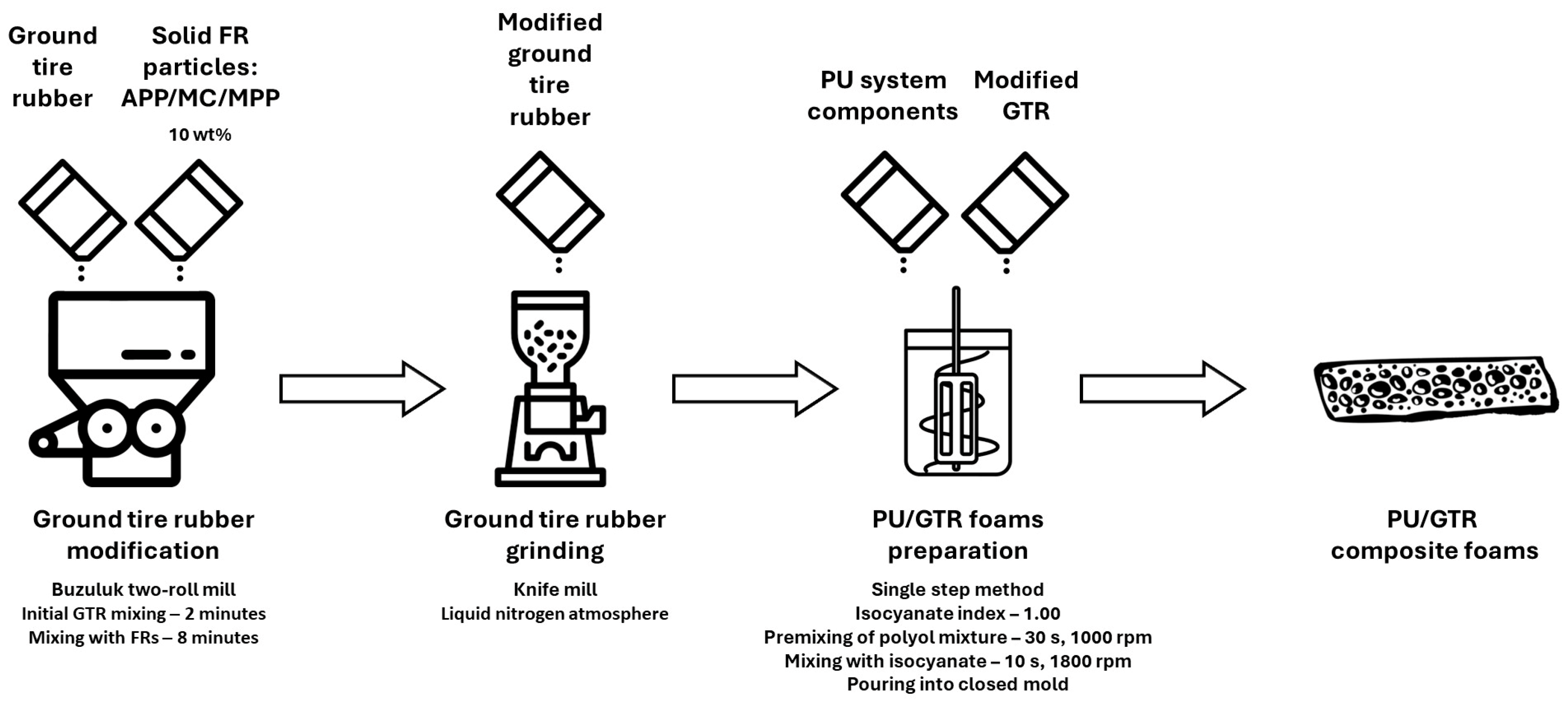
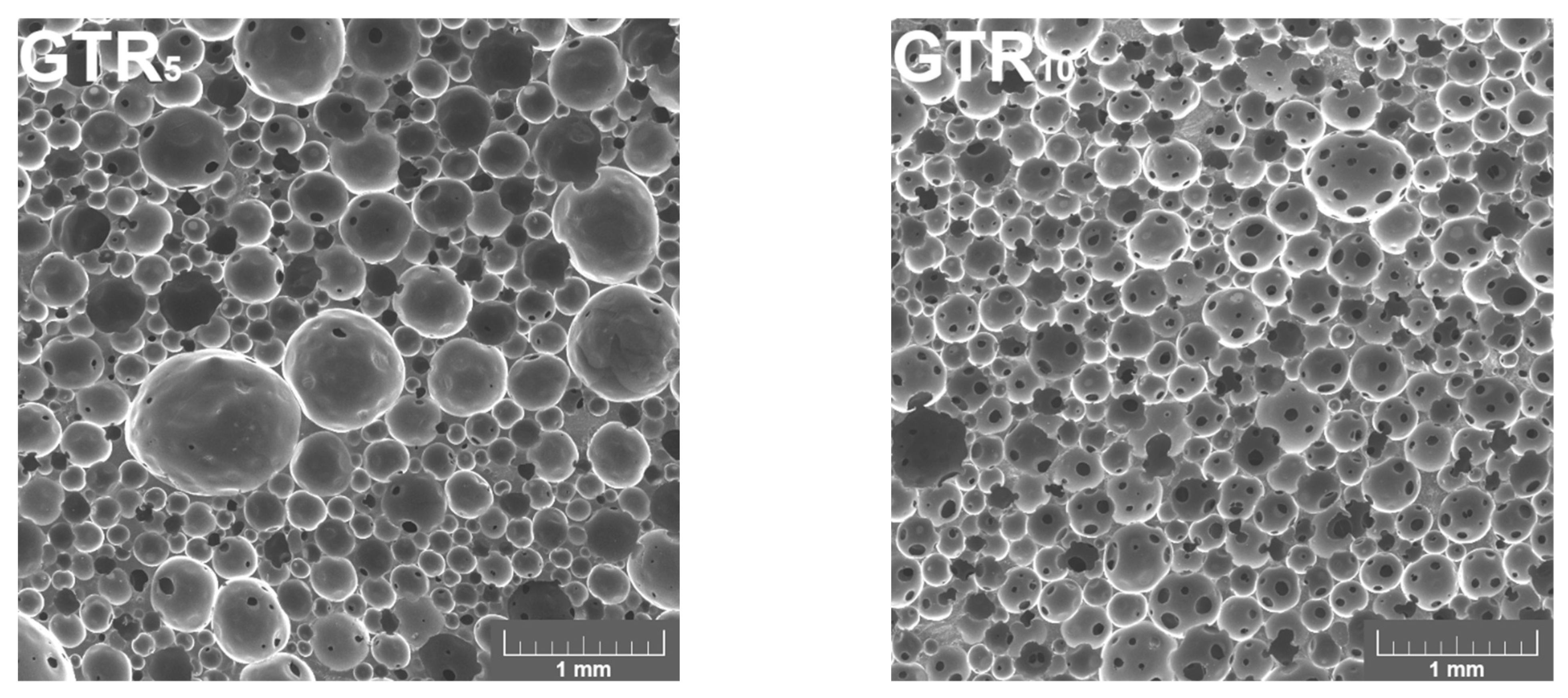
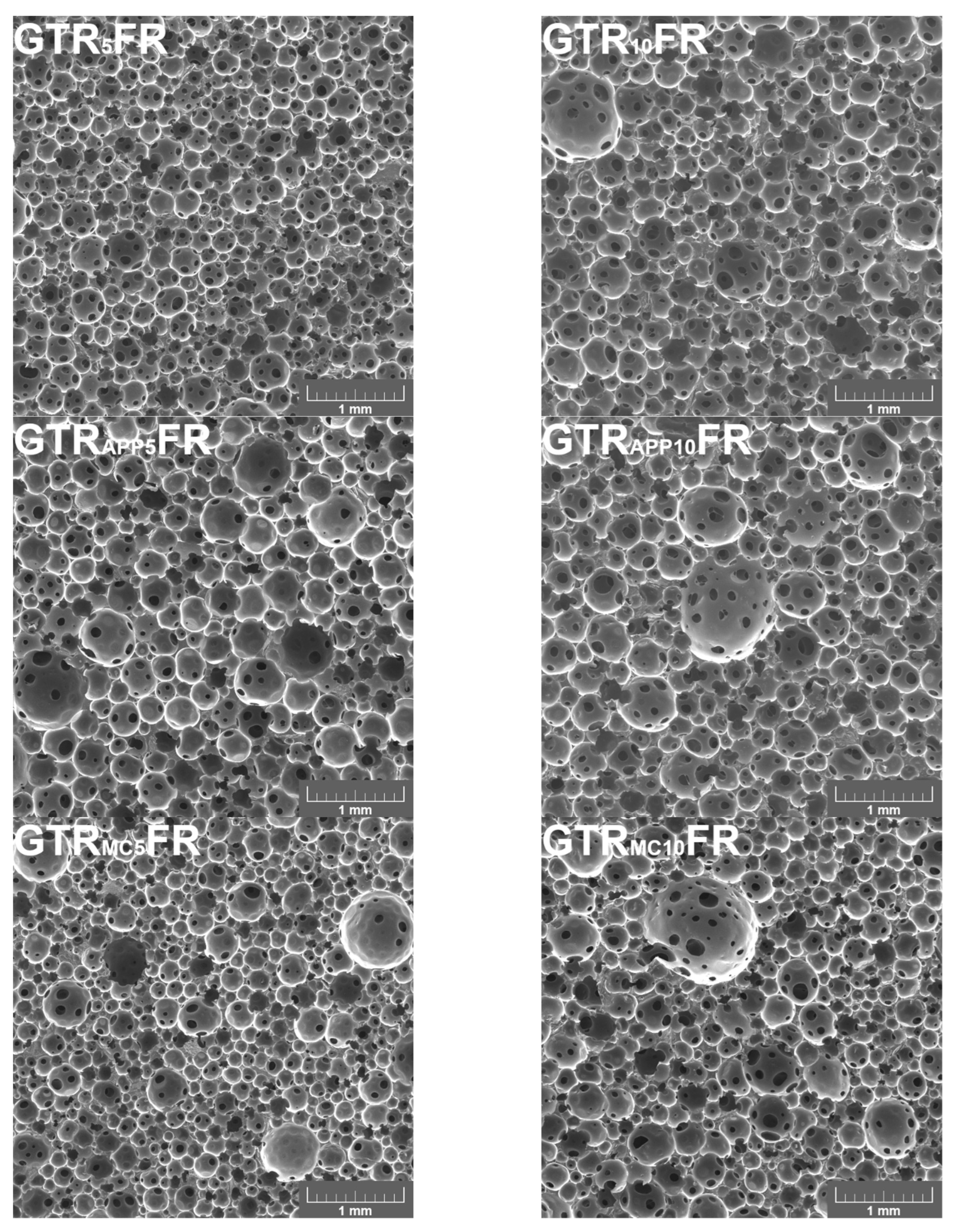


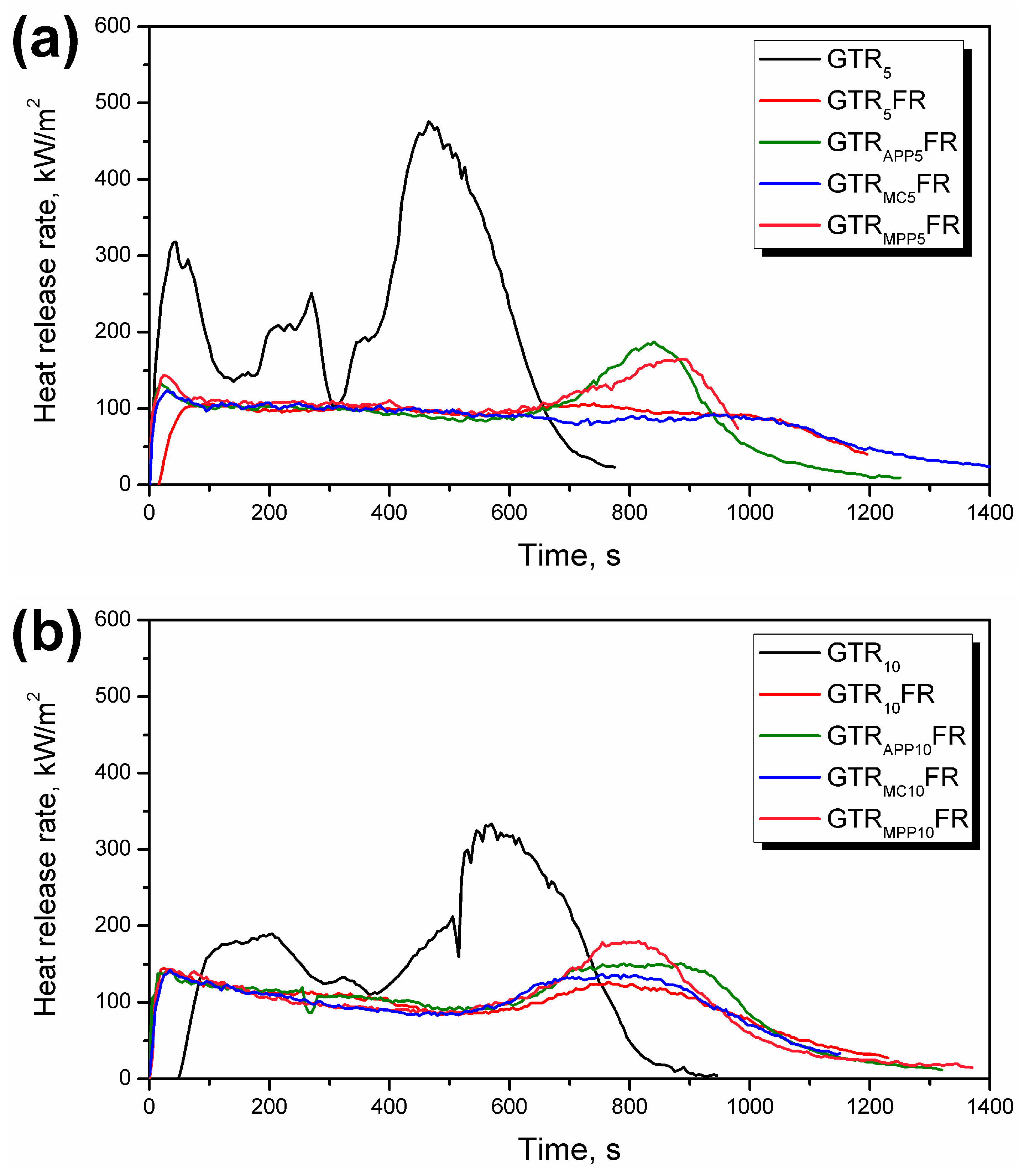
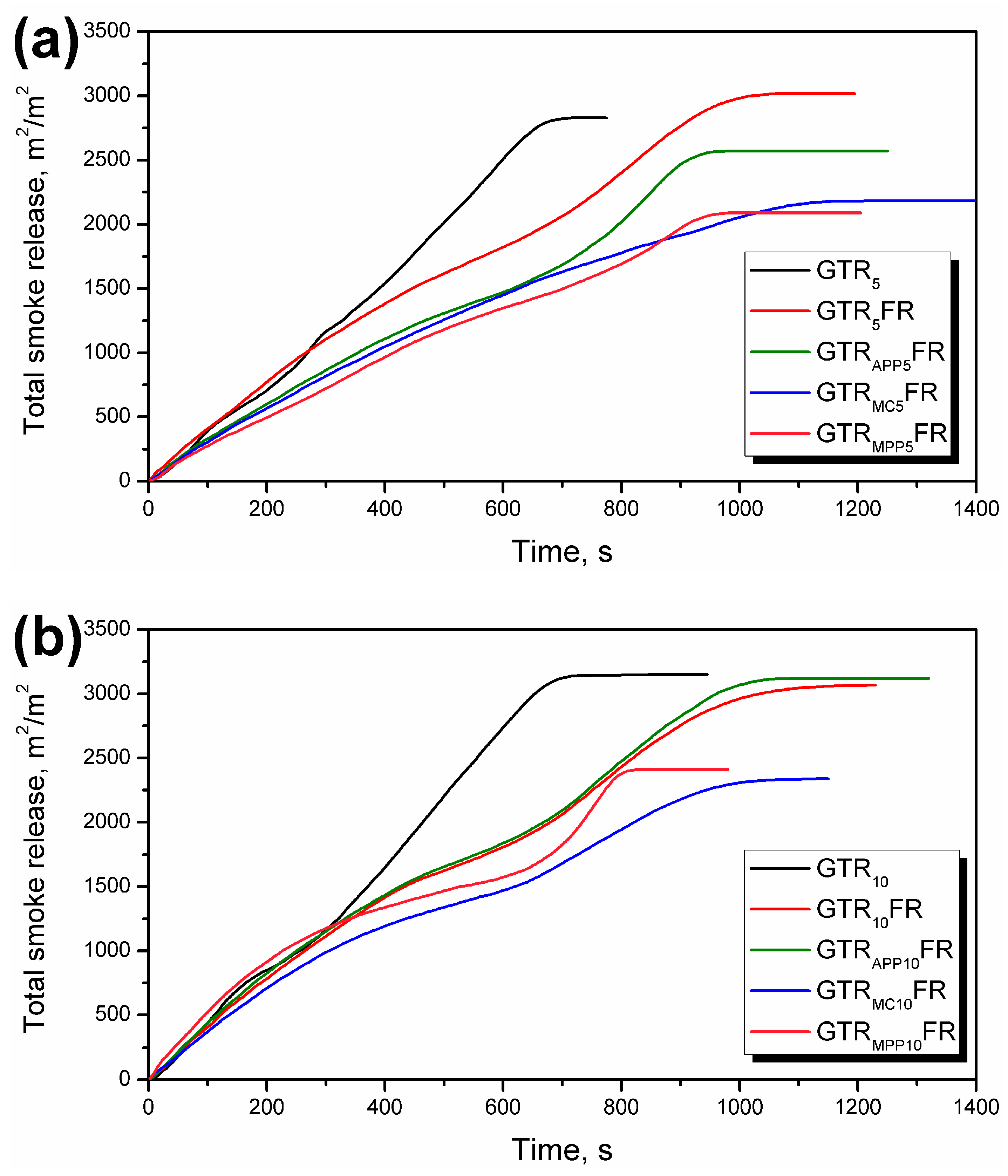
| Material | Properties/Additional Information | Producer |
|---|---|---|
| Rokopol® F3000 | Polyether polyol, hydroxyl value—53–59 mg KOH/g | PCC Group (Brzeg Dolny, Poland) |
| Rokopol® V700 | Polyether polyol, hydroxyl value—225–250 mg KOH/g | PCC Group (Brzeg Dolny, Poland) |
| Glycerol | Hydroxyl value—1800 mg KOH/g | Sigma Aldrich (Poznań, Poland) |
| SPECFLEX NF 434 | Polymeric methylenediphenyl-4,4′-diisocyanate (pMDI), free isocyanate content—29.5% | M. B. Market Ltd. (Baniocha, Poland) |
| PC CAT® TKA30 (KAc) | Potassium acetate catalyst | Performance Chemicals (Belvedere, UK) |
| DABCO 33LV (DABCO) | Catalyst, 33 wt% solution of 1,4-diazabicyclo[2.2.2]octane in dipropylene glycol | Air Products (Allentown, PA, USA) |
| Dibutyltin dilaurate (DBTD) | Organic tin catalyst | Sigma Aldrich (Poznań, Poland) |
| Distilled water | Chemical blowing agent | - |
| Ground tire rubber | Filler | Recykl S.A. (Śrem, Poland) |
| Expanded graphite | Flame retardant | Nordmann, Rassmann, GmbH (Hamburg, Germany) |
| Roflam P LO (TCPP) | Flame retardant | PCC Group (Brzeg Dolny, Poland) |
| Addforce FR MPP (MPP) | Flame retardant, melamine polyphosphate | WTH Walter Thieme Handel GmbH (Stade, Germany) |
| Budit 314 (MC) | Flame retardant, melamine cyanurate | Chemische Fabrik Budenheim KG (Budenheim, Germany) |
| Addforce FR APP103 (APP) | Flame retardant, ammonium polyphosphate | WTH Walter Thieme Handel GmbH (Stade, Germany) |
| Component | Foam Symbol | |||||
|---|---|---|---|---|---|---|
| GTR5 | GTR10 | GTR5FR | GTR10FR | GTRX5FR | GTRX10FR | |
| F3000 | 59.7 | 59.7 | 49.75 | 49.75 | 49.75 | 49.75 |
| V700 | 59.7 | 59.7 | 49.75 | 49.75 | 49.75 | 49.75 |
| Glycerol | 1.44 | 1.44 | 1.20 | 1.20 | 1.20 | 1.20 |
| DBTD | 1.08 | 1.08 | 0.90 | 0.90 | 0.90 | 0.90 |
| DABCO | 0.72 | 0.72 | 0.60 | 0.60 | 0.60 | 0.60 |
| KAc | 0.72 | 0.72 | 0.60 | 0.60 | 0.60 | 0.60 |
| Water | 0.63 | 0.63 | 0.50 | 0.50 | 0.50 | 0.50 |
| pMDI | 56.04 | 56.04 | 47.03 | 47.03 | 47.03 | 47.03 |
| TCPP | - | - | 14.4 | 14.4 | 14.4 | 14.4 |
| EG | - | - | 14.4 | 14.4 | 14.4 | 14.4 |
| GTR/modified GTR | 8.85 | 17.7 | 7.2 | 14.4 | 7.2 | 14.4 |
| Sample | Cell Size, µm | Circularity | Aspect Ratio | Roundness | Open Cell Content, % | λ Coefficient, mW/(m·K) | Tensile Strength, kPa | Elongation at Break, % |
|---|---|---|---|---|---|---|---|---|
| GTR5 | 248 ± 69 | 0.48 ± 0.23 | 1.39 ± 0.16 | 0.73 ± 0.08 | 80.8 ± 0.7 | 62.1 ± 2.4 | 268.9 ± 7.9 | 116.2 ± 4.4 |
| GTR10 | 209 ± 50 | 0.48 ± 0.21 | 1.32 ± 0.15 | 0.77 ± 0.08 | 80.7 ± 1.9 | 57.1 ± 2.5 | 202.4 ± 9.1 | 101.7 ± 5.8 |
| GTR5FR | 202 ± 36 | 0.54 ± 0.20 | 1.30 ± 0.17 | 0.78 ± 0.09 | 83.7 ± 0.4 | 68.4 ± 2.4 | 105.2 ± 3.1 | 80.2 ± 4.4 |
| GTR10FR | 223 ± 67 | 0.47 ± 0.21 | 1.35 ± 0.17 | 0.75 ± 0.09 | 82.0 ± 1.0 | 71.9 ± 2.0 | 114.5 ± 4.0 | 82.6 ± 6.7 |
| GTRAPP5FR | 226 ± 47 | 0.46 ± 0.20 | 1.34 ± 0.13 | 0.75 ± 0.07 | 82.4 ± 1.4 | 79.3 ± 2.5 | 145.6 ± 2.1 | 82.2 ± 3.6 |
| GTRAPP10FR | 233 ± 74 | 0.41 ± 0.25 | 1.37 ± 0.14 | 0.74 ± 0.08 | 83.8 ± 3.6 | 78.9 ± 1.5 | 129.0 ± 4.5 | 80.4 ± 5.9 |
| GTRMC5FR | 217 ± 59 | 0.48 ± 0.21 | 1.32 ± 0.11 | 0.76 ± 0.06 | 84.7 ± 2.5 | 75.6 ± 2.3 | 125.3 ± 5.2 | 72.8 ± 5.2 |
| GTRMC10FR | 228 ± 54 | 0.46 ± 0.21 | 1.34 ± 0.16 | 0.75 ± 0.08 | 85.6 ± 0.7 | 76.4 ± 1.5 | 112.9 ± 4.5 | 66.2 ± 5.2 |
| GTRMPP5FR | 234 ± 61 | 0.48 ± 0.22 | 1.35 ± 0.14 | 0.75 ± 0.08 | 85.1 ± 1.0 | 76.6 ± 2.2 | 136.8 ± 7.2 | 73.8 ± 2.8 |
| GTRMPP10FR | 234 ± 58 | 0.50 ± 0.18 | 1.35 ± 0.12 | 0.75 ± 0.06 | 83.3 ± 3.6 | 72.5 ± 2.1 | 121.3 ± 2.7 | 68.0 ± 4.7 |
| Sample | LOI, %v/v | TTI, s | pHRR, kW/m2 | MARHE, kW/m2 | THR, MJ/m2 | EHC, MJ/kg | SEA, m2/kg | TSR, m2/m2 | Char Yield, % | FRI (Label) |
|---|---|---|---|---|---|---|---|---|---|---|
| GTR5 | 20.0 | 8 ± 3 | 461 ± 20 | 279 ± 33 | 167 ± 2 | 22 ± 0 | 380 ± 19 | 2906 ± 111 | 9.9 ± 1.2 | *RS |
| GTR10 | 19.4 | 21 ± 1 | 368 ± 49 | 208 ± 45 | 150 ± 16 | 19 ± 3 | 409 ± 6 | 3230 ± 116 | 11.5 ± 0.9 | RS |
| GTR5FR | 28.2 | 10 ± 5 | 119 ± 18 | 95 ± 0 | 107 ± 5 | 17 ± 1 | 431 ± 21 | 2839 ± 251 | 26.4 ± 0.6 | 7.56 (Good) |
| GTR10FR | 26.6 | 6 ± 0 | 144 ± 2 | 112 ± 20 | 113 ± 6 | 19 ± 2 | 484 ± 16 | 3390 ± 458 | 27.8 ± 0.1 | 0.97 (Poor) |
| GTRAPP5FR | 27.0 | 9 ± 0 | 187 ± 2 | 114 ± 1 | 108 ± 1 | 17 ± 1 | 409 ± 10 | 2571 ± 68 | 26.8 ± 0.0 | 4.29 (Good) |
| GTRAPP10FR | 26.2 | 7 ± 1 | 154 ± 5 | 127 ± 1 | 124 ± 3 | 19 ± 1 | 486 ± 12 | 3173 ± 84 | 27.3 ± 0.0 | 0.96 (Poor) |
| GTRMC5FR | 28.0 | 8 ± 1 | 138 ± 20 | 142 ± 25 | 115 ± 0 | 18 ± 0 | 363 ± 36 | 2297 ± 162 | 27.5 ± 0.2 | 4.85 (Good) |
| GTRMC10FR | 26.4 | 9 ± 0 | 167 ± 36 | 117 ± 5 | 114 ± 0 | 19 ± 0 | 380 ± 5 | 2665 ± 461 | 28.2 ± 05 | 1.24 (Good) |
| GTRMPP5FR | 29.4 | 7 ± 3 | 165 ± 38 | 132 ± 14 | 122 ± 4 | 19 ± 0 | 338 ± 9 | 2250 ± 228 | 25.2 ± 1.3 | 3.35 (Good) |
| GTRMPP10FR | 27.6 | 9 ± 0 | 191 ± 15 | 129 ± 5 | 131 ± 10 | 20 ± 2 | 397 ± 117 | 2606 ± 829 | 24.9 ± 1.7 | 0.94 (Poor) |
Disclaimer/Publisher’s Note: The statements, opinions and data contained in all publications are solely those of the individual author(s) and contributor(s) and not of MDPI and/or the editor(s). MDPI and/or the editor(s) disclaim responsibility for any injury to people or property resulting from any ideas, methods, instructions or products referred to in the content. |
© 2024 by the authors. Licensee MDPI, Basel, Switzerland. This article is an open access article distributed under the terms and conditions of the Creative Commons Attribution (CC BY) license (https://creativecommons.org/licenses/by/4.0/).
Share and Cite
Kosmela, P.; Sałasińska, K.; Kowalkowska-Zedler, D.; Barczewski, M.; Piasecki, A.; Saeb, M.R.; Hejna, A. Fire-Retardant Flexible Foamed Polyurethane (PU)-Based Composites: Armed and Charmed Ground Tire Rubber (GTR) Particles. Polymers 2024, 16, 656. https://doi.org/10.3390/polym16050656
Kosmela P, Sałasińska K, Kowalkowska-Zedler D, Barczewski M, Piasecki A, Saeb MR, Hejna A. Fire-Retardant Flexible Foamed Polyurethane (PU)-Based Composites: Armed and Charmed Ground Tire Rubber (GTR) Particles. Polymers. 2024; 16(5):656. https://doi.org/10.3390/polym16050656
Chicago/Turabian StyleKosmela, Paulina, Kamila Sałasińska, Daria Kowalkowska-Zedler, Mateusz Barczewski, Adam Piasecki, Mohammad Reza Saeb, and Aleksander Hejna. 2024. "Fire-Retardant Flexible Foamed Polyurethane (PU)-Based Composites: Armed and Charmed Ground Tire Rubber (GTR) Particles" Polymers 16, no. 5: 656. https://doi.org/10.3390/polym16050656
APA StyleKosmela, P., Sałasińska, K., Kowalkowska-Zedler, D., Barczewski, M., Piasecki, A., Saeb, M. R., & Hejna, A. (2024). Fire-Retardant Flexible Foamed Polyurethane (PU)-Based Composites: Armed and Charmed Ground Tire Rubber (GTR) Particles. Polymers, 16(5), 656. https://doi.org/10.3390/polym16050656











